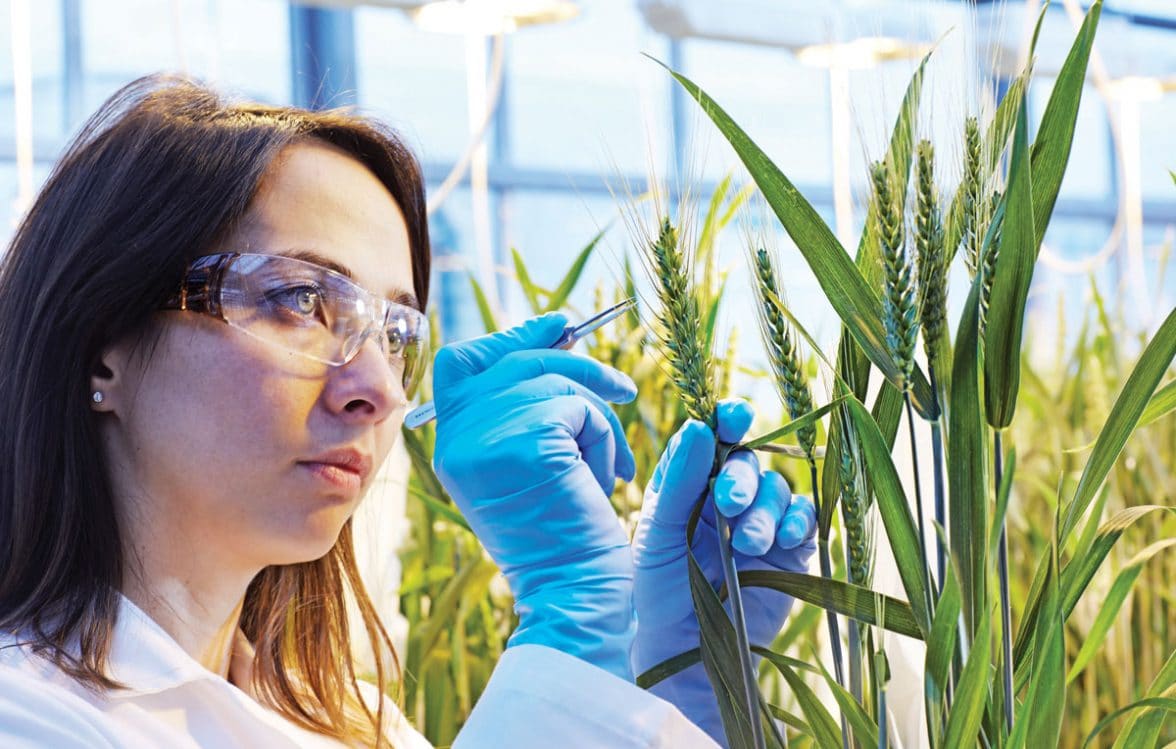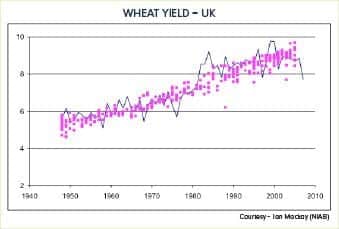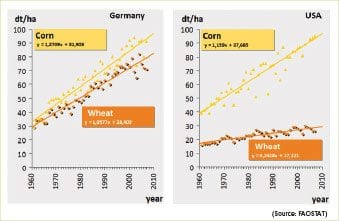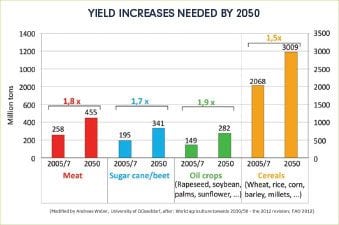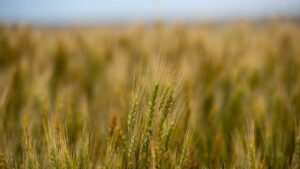Wheat breeding companies share their goals as they face the need to feed the world’s growing population.
Editor’s Note: In each issue of European Seed we take a closer look at one of the many crops that our European plant breeders are working on. In this issue, we’re taking a closer look at wheat, one of the top three food crops on the planet.
Wheat is a crop that does not ‘travel’ well. It needs significant local adaptation to succeed. As a consequence, a major goal for wheat breeding in Europe is to develop varieties for all of the many sub-regions that exist. Whether it is spring or winter wheat, the breadth of coverage possible with single varieties is limited, although within a sub-region a variety can command high market shares if its performance is sufficiently superior to others.
The next key criteria for breeding is the quality group that is being targeted — since wheat has a very diverse usage ranging from animal feed to bakery products and also non-food products. The range of wheat-based products also varies by sub-region within Europe, based on the market preferences for baked goods, the industrial focus and on the ability to produce wheat crops with particular quality parameters (protein content, gluten content, hectolitre weight etc.) due to local environmental conditions.
In addition, legislation on input uses has an influence on the ability of farmers to produce to particular quality standards, impacting the kinds of wheat varieties required. An example of this is the restriction on nitrogen usage in Denmark today.
Once the target region for breeding is identified along with the quality market, yield is the primary breeding goal.
“Breeders aim to produce varieties with the highest yield potential. Once this is achieved, breeders then target resistance to biotic and abiotic stresses to protect the yield potential that they have incorporated,” says Chris Tapsell, head of wheat breeding for KWS, U.K. “In areas under an oceanic climate — northwestern Europe — stiff straw and sprouting resistance are important goals, whereas in Mediterranean areas or areas under continental climate, drought resistance is more important.”
Jayne Stragliati, manager of wheat in Western Europe for Limagrain Europe, agrees. “I think it is good to [put emphasis] on stable yield. For me this is one of the main challenges for a breeder today. Why? Because the biotic and abiotic stresses are never the same due to climatic changes and new races appearing. A good example is the yellow rust Warrior, which is present throughout Europe from Portugal to Eastern Europe. This has never been experienced by wheat breeders before. The importance is to have durable resistance and not main genes.”
Laurent Guerreiro, Director of RAGT, France is not so sure yet: “The final goal would be to have durable resistance, but all the genetic mechanisms of this so called durable resistance are not well known. At the time being, dealing with major genes and combining all these genes is still an important strategy.”
Yield
There has been significant success in increasing yield over time. In the U.K., for more than 60 years, there has been an increase of between 0.5 per cent and one per cent per annum in yield. Until the mid 1980s this was created by a combination of genetic improvement and agronomic improvements, including increasing use of nitrogen and agrochemicals.
More recently in the U.K., the average on-farm yield for wheat appears to have plateaued, and while there continues to be genetic improvements in yield in official trial testing of new varieties, this is not being translated to increases on-farm.
Philippe Lonnet, head of cereal and protein crops breeding for Florimond Desprez in France, concurs. “There is still an increase in yield when you look at trial results. However, [there is also] a reduced improvement or even a plateau when you look at farm yields. This has also been reported in France. Among the different reasons are a higher occurrence of drought periods during grain filling in the last decade, induced by global warming.”
In Germany, there have also been increases in yield of approximately one per cent per annum, similar to those achieved in the U.K. In comparison to corn, where yield increases above one per cent have been achieved both in Europe and in the United States, the lack of investment in wheat breeding both in private and public programs has resulted in a much lower yield increase in the U.S., where increases are only 0.25 per cent per year. Guerreiro adds: “The fact that every European country is facing the same plateau, leads us to take into account more significantly the G*E interaction (genotype* environment interaction). It’s quite complex because as breeding company we need to deal with new areas of expertise such as modelling, pedoclimatic analysis or physiology studies.”
There are regional differences in terms of yield increase. “It is always more difficult to get higher yield in areas already doing 11 tonnes per hectare than in areas at five to six tonnes per hectare,” Stragliati adds. “The French varieties can compete very well in Eastern European countries (like Serbia, Romania, Bulgaria, and Hungary). We find several French varieties on the market such as Apache, which is No. 1 in Serbia. So there is the possibility to ‘travel‘ some wheat varieties.”
To the farmer, yield increase is often seen with the introduction of new ‘landmark’ varieties, bringing either a stepped increase in yield or increased yield accompanied by an improvement in other characteristics.
“Examples of this would be the introduction by KWS of wheat variety Robigus in the U.K., which gave a step increase in yield and which has been the parent of a significant proportion of varieties produced in both the U.K. and other EU countries since its development,” Harold Verstegen, head of breeding for KWS Cereals, notes. “Or in Germany where KWS introduced the variety Julius with high yield and particularly strong winter hardiness, which proved its value in the winter of 2011/12 where severe winter weather significantly impacted the wheat crop.”
“It also is more difficult to breed varieties of wheat for the higher quality markets with as high a yield as for those used in animal feed. This can be seen by yield increases achieved in Germany for different quality classes over a 40-year period from 1965 to 2005,” Verstegen says.
Biotic and Abiotic Stresses
The major diseases of wheat that breeders aim to improve are fusarium, septoria, yellow rust and brown rust. There are also significant regional differences existing for these diseases, and the priority is not the same in all countries.
Fusarium is not an easy disease to breed resistance for, as there are no known complete resistance genes available, so a number of resistance genes need to be stacked to provide sufficient resistance levels. Septoria is now becoming a major focus for breeders, since the chemistry available to farmers is becoming less effective and the resistance sources available need to be stacked to give sufficient resistance.
For the rusts, good chemistry exists to control these diseases as long as there is moderate resistance in the variety. Breeders have utilised many major genes and are continually working on incorporating more durable forms of resistance. Recently, very aggressive populations of yellow rust have appeared in Europe, which are increasing the need to focus on this disease.
Mildew, whilst still a potential problem, has less impact in Europe due to significant success in increasing resistance levels. Interestingly, when varieties from other regions of the world are grown in Europe they are often very susceptible to mildew.
Orange blossom midge and lemon/yellow blossom midge are also problems for farmers, causing significant yield loss and quality reduction. Breeders have successfully introduced complete resistance to the orange form, but at this time no resistance to lemon/yellow midge is available.
When looking at breeding targets for abiotic stresses, winter hardiness is a key target for breeders in large areas of Europe, but there are areas (like the U.K.) where this is not required. Heat tolerance during grain filling is also a target for breeders to avoid yield reduction and poor grain quality.
Quality
Breeders can’t focus solely on increasing yield and building resistance — the target end use of wheat also plays a critical part in the equation.
“More than 50 per cent of French wheat is exported, so the quality — baking (bread, protein) and physical (hectolitre weight, grain size, clean seed) are also major breeding targets,” Stragliati says. “There is a lot of pressure to reduce inputs (fungicides, nitrogen etc.) so varieties that have good disease resistance [and also] good protein content with high yield are important. This can also be a problem for the French breeder, as we are breeding high-yielding winter wheat and we find ourselves competing with low-yielding spring wheat but high protein coming from other countries like Kazakhstan. It is the importing market [that] makes its choice.”
Breeding Investment
Lonnet says that until the 1960s or 1970s the pedigree method was almost the only breeding method used and it is still used today — with some improvements being made, such as winter generations, when feasible.
“Two other methods are used more and more — single seed descent (SSD) and double haploids (DH), which can both speed up the breeding cycle by about two years,” Lonnet says.
Breeding is a heavily R&D-focussed industry involving the use of expensive high-tech equipment both for laboratory DNA analysis and field work. It also requires highly skilled and trained staff, and it is often the case that more than 50 per cent of staff in a breeding company will be university graduates.
Since wheat is grown in all temperate regions around the world, it is usually not a problem for the breeder to get access to very diverse protected varieties to use as parental lines. Many centres of the International Board for Plant Genetic Resources (IBPGR), through a standard Material Transfer Agreement (sMTA), also provide public materials such as older varieties or landraces.
“It should in particular be mentioned that the International Maize and Wheat Improvement Center (CIMMYT) in Mexico used to provide a large range of materials, including synthetic wheats, [which are] hexaploid wheats, such as bread wheat, that are produced by crossing diploid Triticum tauschii accessions by tetraploid durum wheats and doubling the obtained F1. Many French wheats have in their pedigree CIMMYT materials that were used because they carried some resistance to abiotic or biotic stress,” adds Lonnet.
“It is often quoted that to breed a new wheat variety it costs, on average, €2 million. Furthermore, it takes between six and 10 years to breed a new variety, followed by three to five years before the variety has passed through national registration trials and is available in sufficient quantities to have an impact on the market,” Verstegen of KWS explains.
Stragliati concurs: “However, thanks to systems like DH and SSD, we can gain two years. Markers also help to identify earlier potential lines so breeders can cross earlier in their material to gain time. I must say that the field still plays a big part [in testing] the variety, but there are ways to go quicker to the field.”
Renewed Interest in Wheat Breeding
The potential opportunities for GM traits to solve recalcitrant problems in wheat (fusarium, for example) and increase yield and nutrient use efficiency have led to some of the major agrochemical and breeding companies entering or re-entering the wheat breeding industry. Wheat is projected to stay as one of the three main food sources currently covering the most arable farming area. Assuming a stable production ratio between rice, corn and wheat, the future demand will be 1.5 times time today’s harvest.
A one per cent yield increase per year from today until 2050 will be insufficient to reach this level of growth, especially when considering there will be less arable land for farming available by 2050 and increased societal pressure for better sustainability. This creates a strong opportunity for traits that ensure yield increase and yield stability with less agronomic inputs.
New Innovations
Wheat breeders have been quick to investigate and adopt all the new DNA technologies available. Public and private initiatives have brought the sequencing of the wheat genome forward and many studies on genome trait analysis have been undertaken [see page 18 for an article on the International Wheat Genome Sequencing Consortium]. Detailed information on what is actually in operational use is hard to obtain, but many if not all companies are involved in R&D in these areas.
There is renewed interest in hybrid wheat and most breeding companies are either working directly on this or are investigating whether to get involved. At the moment, there are hybrid varieties on the market, produced using chemical hybridisation agents. This is technically difficult, expensive and dependent on the deregulation of the agent in each country.
“The kind of heterosis level that can be obtained in wheat is around 10 per cent, maybe up to 15 per cent, but not more. That makes is difficult for a hybrid variety to compete with conventional ones, considering the extra seed cost,” Lonnet says.
Tapsell agrees: “The difficulty in producing seed at an economically efficient price level has always been a bottleneck for hybrid wheat, mainly caused by the hybridisation systems available and their complexities. However, new molecular and seed sorting technologies are changing things, and it is expected that we will see more hybrid wheat varieties in the marketplace around the world in the coming five to 15 years.”
Feeding the World
Breeders are well aware of the looming production targets needed to feed the growing population. The U.K.-based International Wheat Yield Partnership (IWYP) seeks to increase wheat yields by 50 per cent by 2034. The World Bank estimates that global wheat production must increase by 60 per cent to meet rising demand, IWYP notes on its website. Other estimates are even higher.
At the rate of yield improvements achieved to date, such ambitious targets may not be reached. So, the use of GM or new genome editing technology is likely to be a necessary tool to achieve the required production, many believe.
According to the International Service for the Acquisition of Agri-Biotech Applications (ISAAA) website, “Despite the current uncertainty over GM crops, one thing remains clear — this technology, with its potential to create economically important crop varieties, is simply too valuable to ignore.”
The focus on environmental protection, while important, is also disproportionally affecting politics in Europe. Nutrient legislation is currently being introduced that will make increasing wheat production to the required levels to feed the world in the future very difficult. The ISAAA website goes on to note that, “If these issues are to be resolved, decisions must be based on credible, science-based information. Given the importance people place on the food they eat, policies regarding GM crops will have to be based on an open and honest debate involving a wide cross-section of society.”


